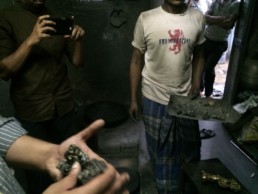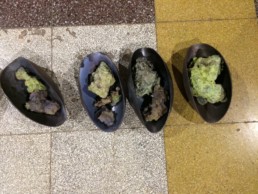Sheep and Bunny
sculpture
curator: Sumesh Sharma
Clark House Initiative, Bombaj, marzec 2015
in cooperation with Polish Institute New Delhi
Dust, forms layers of archaeological interest when it collects within grime and paint over furniture, damp corners of walls, statues and other agents that bring to rest particles of our skin, eroding soil and stone, hair and general minute detritus. Finer particles interlace with hair and other available fibres such as spider webs to create shapes that are furry, light and airborne. Animal associations are often made with these shapes, the Poles prefer to call them cats, the French prefer to associate it with wool and call the collected balls of dust ‘sheep’, and in English they are called ‘dust bunnies’.
In the lanes that descend into tunnels of metal worker shops from Falkland Road there is a certain change in the quality of soil, years of oils, acids, ferrous particles, brass ingots have been paved into the surface, burnt coal and sand gather on the walls and the skin of the workers, at times the road-dust that collects is painted over creating sculptural textures, that are coarse when viewed smooth when touched, much like the anomaly of a ‘Dust Bunny’ – something that sounds endearing but has a revolting constitution. Katarzyna Krakowiak collects dust produced by the people of Bombay and has gathered in its architecture for her project at Clark House Initiative.
A series of bronze scupltures is the only such project in the artistic activity of Katarzyna Krakowiak.


